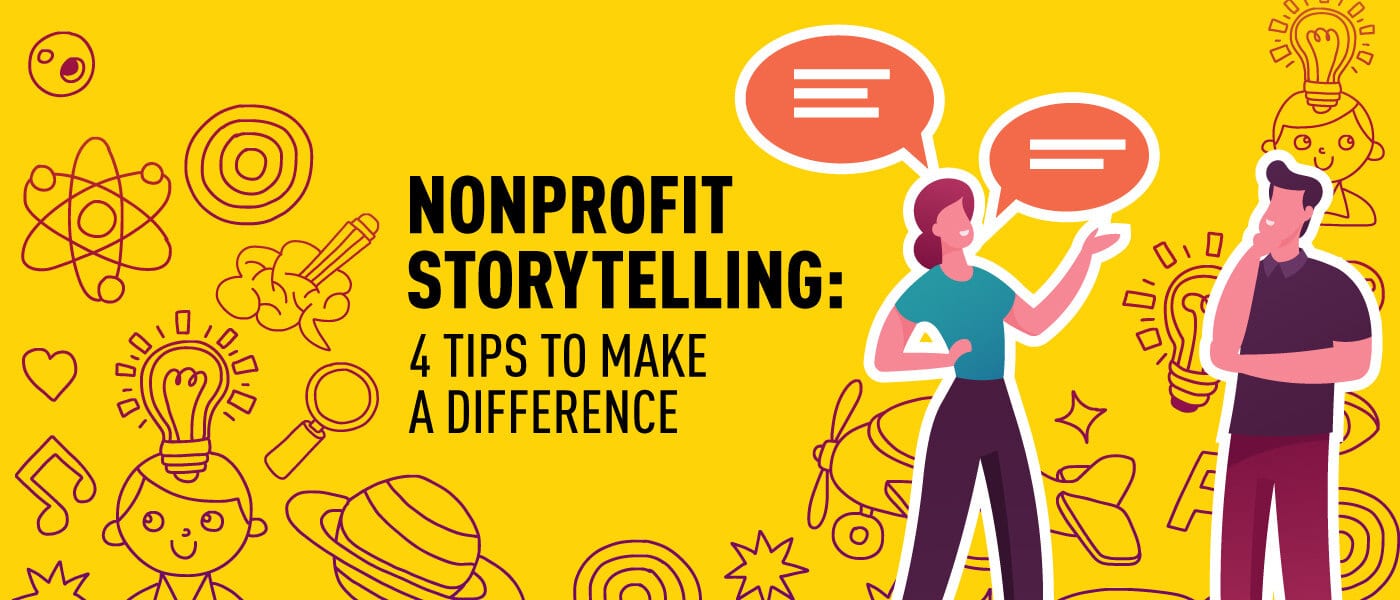
Guest post by Ryan Felix of Loop
Nonprofits rely on the relationships they build with donors for growth and success. With mega gifts on the rise and the number of individual donors decreasing, it’s more important than ever for your nonprofit to capitalize on donor relationships by building emotional connections.
Effective storytelling pulls the heartstrings of supporters, developing an emotional connection between supporters and your nonprofit right off the bat.
When you craft new content for your website or create new marketing materials, leverage storytelling best practices to excite and connect with your audience. This lays the foundation for impactful relationships in the future.
In this guide, we’ll cover how you can use storytelling best practices to acquire more donations and build relationships. Here are the four tips we’ll discuss:
-
Revisit your mission.
-
Include traditional storytelling elements.
-
Focus on empathy.
-
Ensure your design matches your tone.
Stories about your nonprofit’s mission and the impact you have on your community can take your fundraising efforts to the next level. Improve your donor retention rate by telling your unique story with these effective strategies.
1. Revisit your core message.
According to Loop’s nonprofit branding guide, an essential part of your brand is your overarching message. This overarching message encapsulates your mission, vision, and key values. It’s also an important aspect of your stories.
When you tell a story, reflect your core message in the story itself.
Everything should relate to your mission and vision. If you tell the story of a program that provides backpacks and school supplies to children, tie it back to your overarching mission to help inner-city children receive the best possible education.
Donors care about your mission. Relate your stories to the core purpose of your organization to remind donors of why they decided to give in the first place.
Your mission is the foundation of their relationship with your nonprofit, so bring everything back to this important message.
2. Include traditional storytelling elements
If you’re an avid reader, you know the typical storytelling elements found in any great novel. Although you’re not writing a novel, include the elements of a good story as you craft your nonprofit’s marketing initiatives. The elements key to your story include your hero, action, and impact.
Choose a hero.
Traditional storytelling strategists like those at re: Charity would tell you to make the donor the hero of your story. This stewardship strategy gives them the credit for making a difference. However, this type of “savior” language is quickly going out of style.
Instead, portray your constituent as the hero. Don’t infantilize or misrepresent your constituents, but ask them to explain their experience in their own words. Then, share their experiences using a narrative structure that delivers all the information potential supporters want to know.
Consider the following example:
A nonprofit (Inner City Education) works with at-risk kids at inner-city schools, helping them obtain a better education than they may have gotten in the past. This nonprofit sends out a newsletter with the following excerpt:
Jonathan just graduated from Education Academy in the Spring. The average graduation rate for his class was around 50%, and he decided he wanted to be a part of this group. He says, “While it was tempting to drop out to start making money, Inner City Education showed me the value of an education and provided resources to help support my family while I went to class.” Jonathan went to extra tutoring and worked hard to make sure he passed his classes the first time around, helping him graduate on time.
In this story, Jonathan mentions the nonprofit, but the story is focused on him. He is the hero. He leveraged the resources at hand to succeed. Donors will be inspired by his story and feel connected to his success.
Explain the action.
The action or the climax is the peaking point of any story. It holds the reader’s attention and creates suspense before a resolution is reached. Choose your words carefully for this part of your story. If you’re too passive, the climax will fail to hold your readers’ attention and your resolution will be less meaningful.
For example, let’s revisit Jonathan’s story once more:
Jonathan attended school-sponsored events that explained how education is important for stronger financial futures. He was convinced and determined to complete his education. Then, his mother unexpectedly got sick. Although he knew the long-term importance of education, he faced the temptation to drop out of school to make money to cover his mother’s medical bills. He would have done it, too, if there hadn’t been another option for his situation. Jonathan reached out to Inner City Education to discuss his options and found that he could receive outside help for his mother while he finished his education.
This story used a “crucible” to create the climax of the story. Jonathan’s external circumstances were outside of his control. He was left to make a choice between long-term success and current needs, which created suspense for the reader.
End with the impact.
The impact of the story is the resolution, explaining why and how the hero succeeded. Impact ties the story together and provides the opportunity to relate the story back to your mission. If the hero won, share the victory with them! If they still need help, use that as a call to action.
Wrap up your story and provide the next step or message that you’d like to convey to the reader. Now that you have their undivided attention, it’s a perfect time to directly explain the takeaway.
In Jonathan’s example, the impact might look something like this:
Jonathan was referred to Inner City Education by a teacher to discuss his options. He found that he qualified for assistance from the organization until he graduated from high school. With his mom taken care of, Jonathan was free to pursue his education and graduated with honors in the spring.
Jonathan’s story reminds us that many high school students feel forced to drop out when external circumstances prevent them from finishing their education. The long-term benefit is often outweighed by the current need. Your donation to Inner City Education made it possible for Jonathan and dozens of kids like him to graduate this year. From our friends at Education Academy, Thank You!
Wrapping up your story with an impact statement maintains Jonathan as the hero of the story, but also shows the distinct part the donor played in the story.
To see other examples of effective storytelling, research the stories used on the best nonprofit websites. Navigate to their case studies or to past newsletters to read more examples of stories and
3. Focus on empathy.
Storytelling makes experiences more approachable for nonprofit supporters. While your supporters may not have personal connections to the statistics you cite, they can relate to the hero of your story.
To make this connection stronger, write to evoke empathy in your audience. Invite them to feel the same emotions as your hero does by describing the experience your hero is going through.
Describe the physical sensations associated with an emotion. To describe sadness, detail the wetness and saltiness of tears. To describe happiness, discuss the lighthearted energy and glow that accompany the emotion. For example, saying, “Susan was sad” is much less effective than saying, “Susan felt her chest constrict and her eyes welled with tears.”
Even if your story doesn’t make your donors happy, it can provide a sense of accomplishment and satisfaction when they’re able to act on the emotions evoked by the story. If they’re feeling righteous anger, they’ll likely feel satisfaction participating in an advocacy campaign. Meanwhile, if they’re feeling sad, they may be more likely to give or volunteer to help solve the issue described.
4. Ensure your design matches your tone.
One underrated element of a good story is how it’s told. The visual design of your story should reflect both the brand of your nonprofit and the tone of the story you tell.
To start, consider the visual brand you’ve already established. If your nonprofit works with children, you likely have a bright colour palette and a unique, whimsical typeface. This tone of friendliness should carry over to your other marketing materials as well.
Then, consider the emotions you’re trying to convey to your readership. If it’s a sad story, choose cool or dark colours, while a happy story calls for warm colours.
When you visually brand your story, the following strategies will help your story design remain in line with both your brand and story.
-
Include your logo in the story. No matter the context in which you’re writing a story (appreciation letters, fundraising appeals, etc.), include your logo so that your supporters know that they’re reading something from your organization.
-
Choose colours from your colour palette. Use colours that are already in your palette when designing marketing materials. Choose cool colours like blue, green, and purple for sad stories and warm sunny colours like orange and yellow for joyful ones.
-
Use your standard typeface. If you have multiple fonts, choose the one that is most appropriate for the tone of the story. Also, consider the length of text when choosing a font for your story. It will be easier to read sans serif fonts for long text on a screen and serif for printed text. Complicated or all uppercase fonts will be more challenging for stories, which tend to be lengthier than other messages.
If you’re still developing your nonprofit’s brand, reach out to a nonprofit design agency. This will help you determine the right colour palette to choose for your organization, how to create your logo, and other visual elements to represent your organization.
Storytelling is the key for nonprofits to formulate deeper connections with donors. This deep, emotional connection ties back to the empathy the supporters feel for the hero of your story and the impact (or potential impact) of your organization. Use these tips to craft impactful stories that encourage supporters to stay involved long-term, boosting your retention rate.

About the Author
Ryan is a co-founder of Loop: Design for Social Good who brings a strong intuition and insight to create bold, creative & impactful websites. Ryan has led design studios in Toronto and New York using his knowledge of Human Centred Design to increase meaningful conversions and design enjoyable web experiences.
